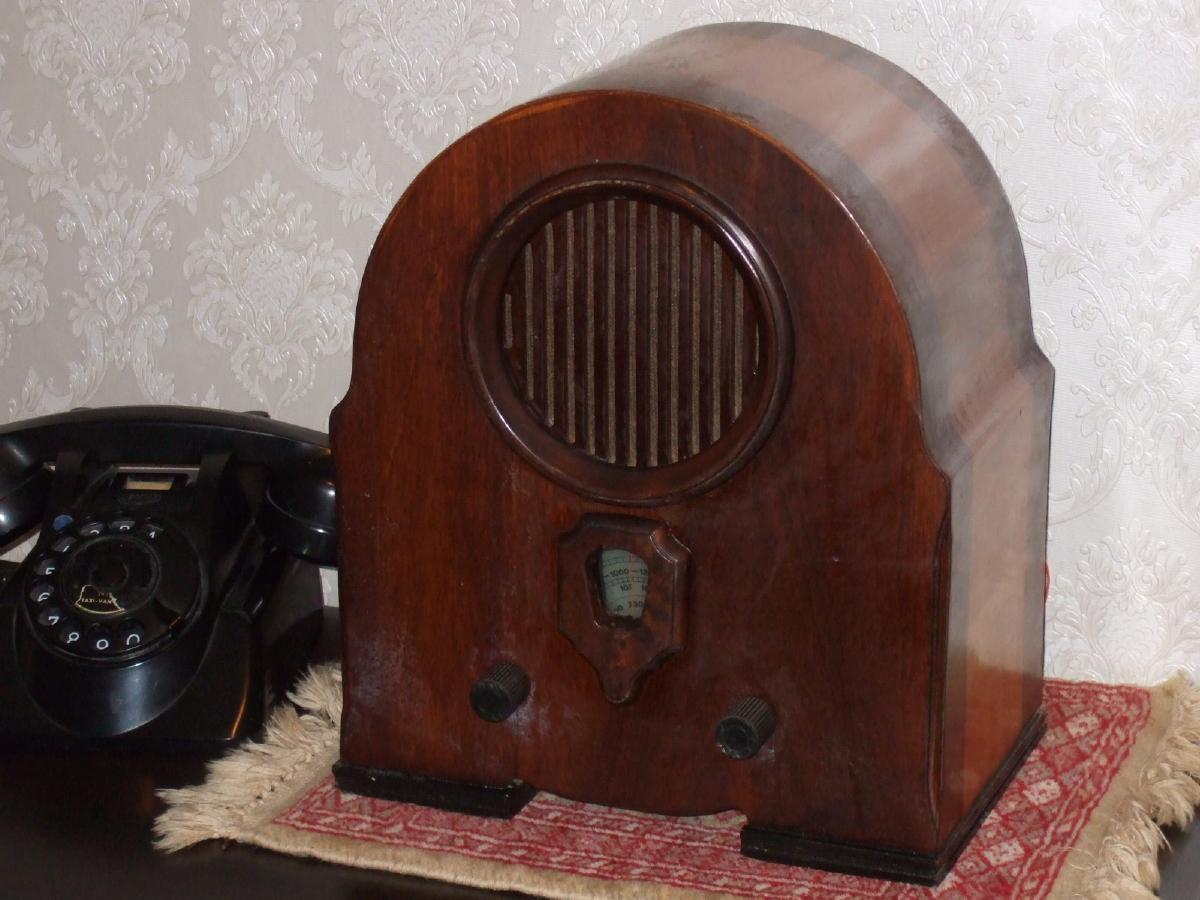 The dating of 1983 can hardly be disputed, because of the abundance of data marks on capacitors and the speaker (40.83).
The dating of 1983 can hardly be disputed, because of the abundance of data marks on capacitors and the speaker (40.83). 
383
Item nr.

Nice wood furniture
| Production | Germany, 1983. |
|---|---|
| Bands | LW (155-260kHz), MW (530-1635kHz), FM (88-105MHz); IF is 455kHz/10.7MHz. |
| Semi- conductors | 10 transistors, 11 diodes. |
| Cabinet | Wood. Size 27x32x18cm. Weight 3kg. |
| Power | AC 230V. |
| Documents | Schema. |
 The dating of 1983 can hardly be disputed, because of the abundance of data marks on capacitors and the speaker (40.83).
The dating of 1983 can hardly be disputed, because of the abundance of data marks on capacitors and the speaker (40.83).
 I was told of replica cathedrals being produced in Germany or Romania (Tehnotron plant). The number slip on the bottom is not completely decisive in this matter.
I was told of replica cathedrals being produced in Germany or Romania (Tehnotron plant). The number slip on the bottom is not completely decisive in this matter.

 The inside reveals a rather simple circuit board with a standard AM/FM transistor set. Observe the very efficient use of switch contacts in the band switch. One section chooses between AM and FM, by connecting one of the HF sections to the AGC line and leaving the other dangling. Another single switch section chooses between LW and MW. A grounded selector will either short half of the antenna coil (MW) or connect an extra capacitor in parallel to the oscillator LC circuit (LW).
The inside reveals a rather simple circuit board with a standard AM/FM transistor set. Observe the very efficient use of switch contacts in the band switch. One section chooses between AM and FM, by connecting one of the HF sections to the AGC line and leaving the other dangling. Another single switch section chooses between LW and MW. A grounded selector will either short half of the antenna coil (MW) or connect an extra capacitor in parallel to the oscillator LC circuit (LW).
| Obtained | 9/2014 from Wim van Toor, sn=23109100. |
|---|---|
| Condition | 7. |
| Disposed | Sold 6/2018. |
| Sound sample | PLAY SOUND Radio Paradijs is always fond of Golden Oldies, so they'll appreciate being heard on this cathedral. |
The back panel didn't bother me much, and the dial light could be replaced.  The tuning cap was very rough in moving, and I suspected it couldn't be repaired. But what are scrap radios for, other than to scrap parts from them? I took the capacitor from an old Mustang portable. It was a bit of a guess, because I knew neither the capacity of the defective, nor the donor capacitor. Nonetheless, I managed to put the new cap inside. And the radio works: I get stations on each of the three bands, and also, it is possible to rotate the tuning knob and get other stations.
The tuning cap was very rough in moving, and I suspected it couldn't be repaired. But what are scrap radios for, other than to scrap parts from them? I took the capacitor from an old Mustang portable. It was a bit of a guess, because I knew neither the capacity of the defective, nor the donor capacitor. Nonetheless, I managed to put the new cap inside. And the radio works: I get stations on each of the three bands, and also, it is possible to rotate the tuning knob and get other stations.

 Unfortunately, after implanting the cap, I found that the capacity value is smaller and it operates in a different direction! On MW, my new cap tunes no lower than 747kHz. But now compare the dials of the ITC (left) and the Mustang (right). When rotating clockwise, the numbers on the left side become visible and frequency gets lower. Which means capacity increases of course. But the Mustang dial has the numbers arranged reversely: its capacity decreases when rotating clockwise.
Unfortunately, after implanting the cap, I found that the capacity value is smaller and it operates in a different direction! On MW, my new cap tunes no lower than 747kHz. But now compare the dials of the ITC (left) and the Mustang (right). When rotating clockwise, the numbers on the left side become visible and frequency gets lower. Which means capacity increases of course. But the Mustang dial has the numbers arranged reversely: its capacity decreases when rotating clockwise.

 To make things worse, the drive wheel was severely torn and after a while the new cap was no longer driven with the dial wheel. My assistant Tom printed new drive wheels for me (left) which I succesfully placed in the radio (right). Of course the old dial could not be used, but with LaTeX I designed and printed a new one.
To make things worse, the drive wheel was severely torn and after a while the new cap was no longer driven with the dial wheel. My assistant Tom printed new drive wheels for me (left) which I succesfully placed in the radio (right). Of course the old dial could not be used, but with LaTeX I designed and printed a new one.